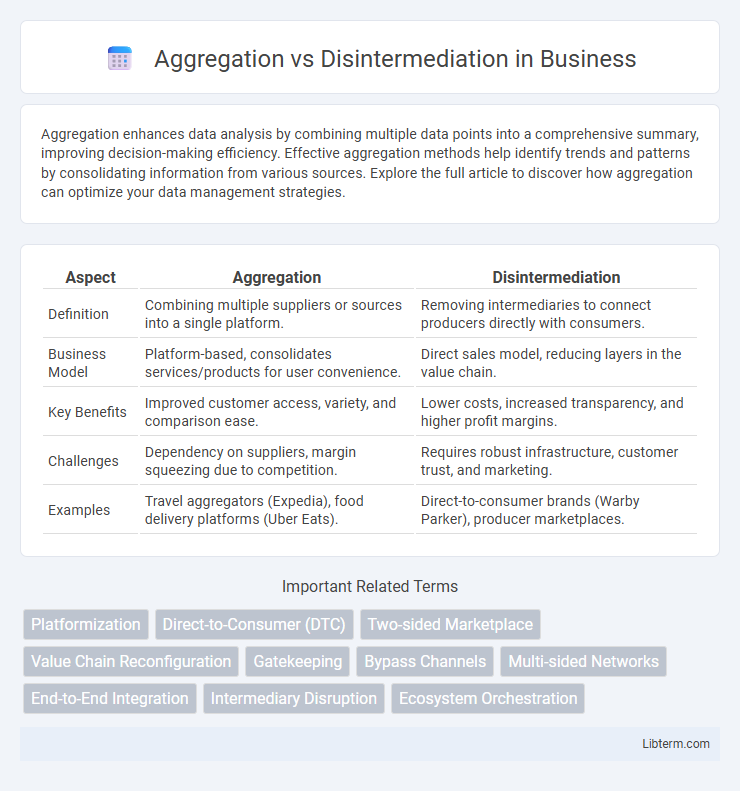Aggregation enhances data analysis by combining multiple data points into a comprehensive summary, improving decision-making efficiency. Effective aggregation methods help identify trends and patterns by consolidating information from various sources. Explore the full article to discover how aggregation can optimize your data management strategies.
Table of Comparison
| Aspect | Aggregation | Disintermediation |
|---|---|---|
| Definition | Combining multiple suppliers or sources into a single platform. | Removing intermediaries to connect producers directly with consumers. |
| Business Model | Platform-based, consolidates services/products for user convenience. | Direct sales model, reducing layers in the value chain. |
| Key Benefits | Improved customer access, variety, and comparison ease. | Lower costs, increased transparency, and higher profit margins. |
| Challenges | Dependency on suppliers, margin squeezing due to competition. | Requires robust infrastructure, customer trust, and marketing. |
| Examples | Travel aggregators (Expedia), food delivery platforms (Uber Eats). | Direct-to-consumer brands (Warby Parker), producer marketplaces. |
Understanding Aggregation and Disintermediation
Aggregation centralizes multiple service providers or products into a single platform, enhancing consumer access and simplifying decision-making processes. Disintermediation removes intermediaries in supply chains or transactions, enabling direct interactions between producers and consumers to reduce costs and improve efficiency. Understanding these concepts helps businesses optimize distribution strategies and enhance customer engagement in digital marketplaces.
Historical Context of Aggregation in Digital Markets
The historical context of aggregation in digital markets traces back to the rise of the internet in the 1990s, where platforms consolidated vast amounts of content and services to offer users centralized access. Early aggregators like Yahoo! and Amazon revolutionized consumer behavior by streamlining search and purchase processes, setting the foundation for modern digital ecosystems. These aggregators gained significant market power by controlling data flows and user engagement, shaping the competitive landscape that later faced challenges from disintermediation trends.
The Rise of Disintermediation in the Digital Age
Disintermediation has surged in the digital age as technology enables direct connections between producers and consumers, bypassing traditional intermediaries. E-commerce platforms, peer-to-peer services, and blockchain-based solutions exemplify how businesses reduce reliance on middlemen to increase efficiency and cost savings. This shift disrupts conventional aggregation models by offering personalized, transparent, and streamlined transactions.
Key Differences Between Aggregation and Disintermediation
Aggregation involves combining multiple products, services, or information sources into a unified platform, enhancing customer convenience and market reach, whereas disintermediation eliminates intermediaries in the supply chain, allowing direct transactions between producers and consumers. Aggregation focuses on centralizing access and increasing efficiency through a single point of contact, while disintermediation reduces costs and improves transparency by removing middlemen. Key differences include the role of intermediaries, operational strategies, and impact on pricing and consumer interaction models.
Benefits of Aggregation for Businesses and Consumers
Aggregation streamlines business operations by consolidating multiple services or products into a single platform, enhancing efficiency and reducing transaction costs. Consumers benefit from aggregation through increased access to diverse options, greater price transparency, and simplified decision-making. This centralized approach fosters competitive pricing and improved personalized experiences, driving customer satisfaction and loyalty.
Advantages of Disintermediation in Modern Commerce
Disintermediation in modern commerce eliminates intermediaries, reducing costs and increasing profit margins for businesses by enabling direct transactions with consumers. It enhances customer experience through personalized services and faster delivery by leveraging digital platforms and data analytics. This transparent supply chain fosters trust and agility, allowing companies to quickly adapt to market changes and consumer demands.
Challenges and Limitations of Aggregation Models
Aggregation models face challenges such as dependency on third-party data quality, which can lead to inaccuracies and inconsistent user experiences. Scalability issues arise when aggregators attempt to integrate diverse and rapidly changing data sources, causing delays and system inefficiencies. Limited control over supplier relationships and pricing transparency also restricts the aggregator's ability to customize offerings and maintain competitive advantages.
Risks and Barriers Associated with Disintermediation
Disintermediation carries risks such as loss of expert intermediaries who provide valuable market knowledge and trust, which can lead to increased transaction costs and reduced efficiency. Barriers include technological challenges, lack of consumer trust in direct channels, and regulatory hurdles that protect intermediaries' roles in supply chains. Companies may face resistance from established intermediaries, making the transition to disintermediation complex and costly.
Real-World Examples: Aggregators vs. Disintermediators
Aggregators like Uber and Airbnb consolidate service providers on a single platform, offering consumers a wide range of options while maintaining intermediary control. In contrast, disintermediators such as Tesla bypass traditional dealerships entirely, selling directly to customers and eliminating middlemen to reduce costs and increase control over the customer experience. This distinction highlights how aggregators enhance market access by connecting users with multiple providers, whereas disintermediators streamline supply chains by removing intermediaries.
Future Trends: The Evolving Balance Between Aggregation and Disintermediation
Future trends indicate a dynamic shift in the balance between aggregation and disintermediation, driven by advancements in AI, blockchain, and decentralized technologies. Aggregators continue to enhance user experience by consolidating data and services, while disintermediation leverages direct peer-to-peer models to reduce reliance on intermediaries. Emerging business models will increasingly blend aggregation's efficiency with disintermediation's transparency, reshaping digital marketplaces and supply chains.
Aggregation Infographic

 libterm.com
libterm.com